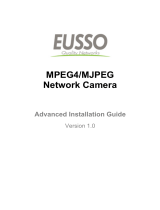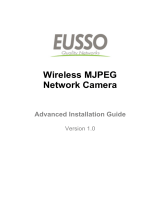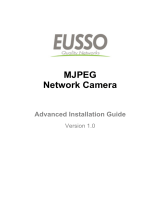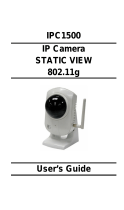Page is loading ...

Model: XIP3101
Wireless IP Camera with IR Night
Vision & 3G Mobile Phone Access
Model:
XIP3101
Wireless IP Camera with IR Night
Vision & 3G Mobile Phone Access
Before you begin
•
Please unpack the box carefully and identify that all the parts are present.
•
Do not cut the camera cables, this will void the warranty.
•
Make sure you use only the recommended power supply. Damage caused to the camera by
incorrect voltage or wiring is not covered by the warranty.
The camera is suitable for indoor or outdoor use (using optional housing). Please bear in mind
the following points when choosing a mounting position.
•
The camera must be positioned so that it will not point directly into the sun (sunrise and
sunset) or any bright light, as this may cause damage to the camera.
•
Avoid viewing areas where half the area is in bright sunlight and the other half is dark,
such as in the shadow of a building. All types of cameras have difficulty in ‘seeing’ with
such a large lux level variation.
IP CCTV
Advanced Installation Guide
Optional Weather Resistant
Housing & Bracket
(Model: XIP3000H)

PREFACE
Thank you for purchasing the XIP3101 Wireless IP CCTV Camera, a
powerful IP CCTV camera with 2-way audio function that provides
high-quality images and audio via an Internet connection. The Infrared
LEDs and light sensor enable the camera to capture images even in a
dark environment. The camera can be installed as a standalone system
within your application environment easily and quickly, and supports
remote management function so that you can access and control it
using a Web browser on your PC.
This
Advanced Installation Guide provides you with the instructions
and illustrations on how to use your camera, which includes:
Chapter 1 Introduction to Your Camera describes the features of
the camera. You will also know the components and
functions of the camera.
Chapter 2 Hardware Installation helps you install the camera
according to your application environment. You can use
this camera at home, at work, at any where you want.
Chapter 3 Accessing the Camera lets you start using your camera
without problem. The camera can be set up easily and
work within your network environment instantly.
Chapter 4 Configuring the Camera guides you through the
configuration of the camera using the web browser on
your PC.
Chapter 5 Appendix provides the specification of the camera and
some useful information for using your camera.
NOTE The illustrations and configuration values in this guide
are for reference only. The actual settings depend on
your practical application of the camera.
- 1 -

-2-
Contents
Preface .......................................................................................................... 1
Chapter 1 Introduction To Your Camera ..................................................... 3
1.1 Checking the Package Contents ................................................... 3
1.2 Getting to Know Your Camera ...................................................... 4
1.3 Features and Benefits .................................................................... 6
1.4 System Requirement ..................................................................... 8
Chapter 2 Hardware Installation ................................................................. 9
2.1 Installing the Camera Stand .......................................................... 9
2.2 Connecting the Camera to LAN/WLAN ....................................... 10
2.3 Applications of the Camera ......................................................... 11
Chapter 3 Accessing the Camera .............................................................. 12
3.1 Using IPFinder .............................................................................. 12
3.2 Accessing to the Camera ............................................................. 13
3.3 Configuring the IP Address of the PC .......................................... 16
Chapter 4 Configuring the Camera ........................................................... 17
4.1 Using the Web Configuration...................................................... 17
4.2 Using Smart Wizard ..................................................................... 18
4.3 Basic Setup ................................................................................... 21
4.4 Network Settings ......................................................................... 23
4.5 Setting up Video & Audio ............................................................ 29
4.6 Event Server Configuration ......................................................... 34
4.7 Motion Detect .............................................................................. 37
4.8 Event Config ................................................................................ 38
4.9 Tools ............................................................................................. 41
4.10 USB ............................................................................................... 43
4.11 Information .................................................................................. 45
Chapter 5 Appendix ................................................................................... 46
A.1 Specification ................................................................................ 46
A.2 Glossary of Terms......................................................................... 48

CHAPTER 1
I
NTRODUCTION TO YOUR CAMERA
1.1 Checking the Package Contents
Check the items contained in the package carefully. You should have
the following:
l One Wireless IP CCTV Camera.
l One AC Power Adapter.
l One External Antenna.
l One Camera Bracket.
l One Ethernet Cable (RJ-45 type).
l One Installation CD-ROM.
l One Quick Installation Guide.
NOTE Once any item contained is damaged or missing, contact your
local distributor.
- 3 -

1.2 Getting to know your Camera
- 4 -
Power LED indicates
the camera is powered
on with the steady
amber light
Lens Assembly
Link LED indicates the
camera’s network
connectivity with the
flashing green light
Light Sensor (optional)
is used to trigger on and
off the Infrared LEDs
according the
environmental light level.
Infrared LEDs (optional)
allows your camera to
capture clear image in a
dark environment.
Internal Microphone
allows the camera to
receive sound and voice.
USB Port*allows you to
connect an external USB
device.
It provides the power
distribution up to 500mA.
USB Unmount Button is
used to remove the
connected USB device
safely.
* The camera’s USB port supports WCN (Windows Connect Now)
technology, which allows you to use the notebook computer to set
up and store your wireless networking configuration on the USB
storage device, and then retrieve the wireless settings when you
connect the USB storage device to the camera.
NOTE After pressing the Unmount button for four seconds, the
Power LED starts flashing. When the Power LED resumes the steady
amber light, you can remove the USB device safely.
Front View

External Antenna
Screw Hole is used
to connect the camera
stand.
Audio-out Connector (for 2-
way audio model) is used to
connect an external active
speaker.
Ethernet Cable Connector
is used to connect the network
cable, which supports the NWay
protocol so that the camera can
detect the network speed
automatically.
DC Power Connector
is used to connect the
AC power adapter, in
order to supply power
to the camera.
Reset Button will restart
the camera when it is
pressed quickly; when it is
long pressed for five
seconds, the camera will
resume the factory default
settings.
Rear View
-5-

1.3 Features and Benefits
MPEG4/MJPEG/RTSP Supported
The camera provides you with excellent images by the
MPEG4/MJPEG/RTSP triple codec selectable technology, allowing
you to adjust image size and quality, and bit rate accordingly to
the networking environment.
Audio Capability
The built-in microphone of the camera provides on-the-spot
audvia the Internet, allowing you to monitor the on-site voice. In
addition, you can connect an external speaker to the camera to
speak through the camera; the camera is embedded with echo
cancellation processor to provide a better sound quality.
Day & Night Surveillance Supported
The six Infrared LEDs around the lens enable the camera to
capture crystal clear images in a dark environment or at night.
When the Light Sensor detects the environmental light level
dropping, the camera captures the images in black & white
mode and turns on the infrared LEDs.
Supports Triple Streaming Profiles
The camera supports multiple profiles simultaneously, so that
you can separately set up different image settings (such as image
quality and frame rate) for MJPEG, MPEG4 and 3GPP.
Supports RTSP
The camera supports RTSP (Real Time Streaming Protocol), which is
a technology that allows you to view streaming media via the
network. You can view the real-time video with the Quick Time
player or RealPlayer. To view the real time streaming image on
your computer, open the Web browser and enter the RTSP link:
rtsp://(IP address of the camera)/mpeg4.
n
n
n
n
n
- 6 -

Remote Control Supported
By using a standard Web browser or the bundled Xview
Recording & Viewing Software software application, the
administrator can easily change the configuration of the camera
via Intranet or Internet. In addition, the camera can be upgraded
remotely when a new firmware is available. The users are also
allowed to monitor the image and take snapshots via the
network.
Supports Connection to the External Devices
With the auxiliary Input/Output connectors, you can connect the
camera to a variety of external devices, such as the external
speaker and the USB device.
Multiple Platforms Supported
The camera supports multiple network protocols, including
TCP/IP, SMTP e-mail, HTTP, and other Internet related protocols.
Therefore, you can use the camera in a mixed operating system
environment, such as Windows 2000 and Windows XP.
Multiple Applications Supported
Through the remote access technology, you can use the cameras
to monitor various objects and places for your own purposes. For
example, babies at home, patients in the hospital, offices and
banks, and more. The camera can capture both still images and
video clips, so that you can keep the archives and restore them
at any time.
3G Mobile Phone/PDA Support
The camera can be viewed live using any compatible 3G Mobile
Phone or PDA that supports 3GPP, Real Player or Quick Time.
n
n
n
n
n
- 7 -

1.4 System Requirement
Networking
LAN: 10Base-T Ethernet or 100Base-TX Fast Ethernet.
WLAN: IEEE 802.11b/g (Model XIP3001 only).
Configuring the Camera:
CPU: Pentium 3, 350MHz or above
Memory Size: 128MB or above
Resolution: 800 x 600 or above
Browser: Internet Explorer 6.0 or above
Operating Systems: Windows 2000/XP/Vista
Viewing the Camera:
CPU: Pentium 3, 350MHz or above
Memory Size: 128MB or above
Resolution: 800 x 600 or above
Browser: Internet Explorer 6.0 or above, Apple Safari 2.0 or
Mozilla Firefox
Operating Systems: Windows 2000/XP/Vista, Apple OSX
*Please note audio is not available when using Safari or Firefox
Accessing the camera using Xview Recording & Viewing
Software
Resolution: 1024 x 768 or above
Operating Systems: Windows 2000/XP/Vista
NOTE If you connect multiple cameras to monitor various places
simultaneously, you are recommended to use a computer with
higher performance.
n
n
n
n
- 8 -
1 camera connected:
CPU: Pentium 3, 800MHz
Memory Size: 512MB
2 to 4 cameras connected:
CPU: Pentium 3, 1.3GHz
Memory Size: 512MB
5 to 8 cameras connected:
CPU: Pentium 4, 2.4GHz
Memory Size: 1.0GB
9 to 16 cameras connected:
CPU: Pentium 4, 3.2GHz
Memory Size: 1.0GB

CHAPTER 2
H
ARDWARE INSTALLATION
2.1 Installing the Camera Stand
The camera comes with a camera stand, which uses a swivel ball
screw head to lock to the camera’s screw hole. When the camera
stand is attached, you can place the camera anywhere by mounting
the camera through the three screw holes located in the base of the
camera stand.
- 9 -

2.2 Connecting the Camera to LAN/WLAN
Use the provided Ethernet cable to
connect the camera to your local area
network (LAN).
When you connect the AC power
adapter, the camera is powered on
automatically. You can verify the
power status from the Power LED on
the front panel of the camera.
Once connected, the Link LED starts
flashing green light and the camera is
on standby and ready for use now.
If you use a wireless network in your
application environment, you need
to attach the included external
antenna to the camera.
When the camera is powered on, the
camera will automatically search any
access point with “default” SSID.
Connecting the Ethernet Cable
Connecting the External Antenna
NOTE If the camera cannot to your wireless network, you need to install
the camera in LAN and proceed with WLAN settings.
-10-

2.3 Applications of the Camera
The camera can be applied in multiple applications, including:
Monitor local and remote places and objects via Internet or Intranet.
Capture still images and video clips remotely.
Upload images or send email messages with the still images attached.
The following diagram explains one of the typical applications for your
camera and provides a basic example for installing the camera.
*
*Please enclosed by waterproof
housing when using in outdoor
Home Applications
-11-

CHAPTER 3
A
CCESSING THE CAMERA
3.1 Using IPFinder
The camera comes with a conveniently utility, IPFinder, which is
included in the Installation CD-ROM, allowing you to search the
camera on your network easily.
1. Insert the Installation CD-ROM into your computer’s CD-ROM
drive to initiate the Auto-Run program.
2. Click the IPFinder item to launch the utility. The control panel will
appear as below.
3. Once you get the IP address of the camera, launch the Web browser
or Xview Recording & Viewing Software to access your camera.
- 12 -
Display the connected
camera(s)
Double click to link the
camera
Click About to get the Version information of IPFinder.
Click
Link to connect the selected camera.
Click
Search to find the IP address of the connected camera(s).
Click
Change IP to modify the IP address of the selected camera.
Click
Exit to close the utility.

3.2 Accessing to the Camera
Whenever you want to access the camera:
1. Open the Web browser on your computer (for example, Microsoft
Internet Explorer in this guide)
2. Type the default IP address (192.168.0.30) or the IP address found by
IPFinder in the Address bar, and then press [Enter].
3. When the login window appears, enter the default User name (admin)
and password (admin) and press OK to access to the main screen of
the camera’s Web Configuration.
Enter the IP address of
the camera here.
Enter the User name
and Password.
NOTE If you are initially access to the camera, you will be ask to install a
new plug-in for the camera. Permission request depends on the
Internet security settings of your computer. Click Yes to proceed.
-13-

After you login into the Web Configuration of the camera, the main page
will appear as below:
Zoom In Buttons
Ni
g
htmode Button
Live View/Setu
p
Switch
Camera Information
Compression Buttons
Function Buttons
Live View Ima
g
e
The main page of the Web Configuration provides you with many useful
information and functions, including:
Camera Information
– Display the camera’s location and the current
date & time. The information can be modified in the Web
Configuration.
Live View Image
– Displays the real-time image of the connected
camera.
Live View/Setup Switch
– Click Setup to configure the camera. For
details, see Chapter 4.
Compression Buttons
– Select to transmit and record the video
using MPEG4 or MJPEG compression.
-14-

-15-
Function Buttons
– Use these buttons to control the audio and
video functions.
z Manual Record allows you to record and save a video clip.
z Snapshot allows you to capture and save a still image.
z Browse allows assign the destination folder to store the video
clips and still images.
z Talk allows you to speak out through the camera. Please note
that this button displays only for the 2-way audio model, and
only one user is allowed to use this function at a time.
z Listen allows you receive the on-site sound and voice from the
camera.
Zoom In Buttons
– Click the buttons to zoom in the live view image
by 1x, 2x, and 3x.
Nightmode Button
– Click the button to enable the “nightshot
mode” to deliver clearer images in the dark environment. However,
this will reduce the frame rate of video setting.
NOTE If your PC use Microsoft Vista platform. Maybe you can’t find these
recorded files what stored by Snapshot or Manual Record. That
you need to disable the protected mode of Security in the IE
Browser. Please follow as below Steps:
1. Open IE Browser
2. Select ToolsÆInternet Options
3. Select Security
4. Disable the ”Enable Protected Mode” then press OK

-16-
3.3 Configuring the IP Address of the PC
If you are failed to access to the camera, please check the IP address of
your computer. When you connect the camera to your computer directly
to proceed with configuration of the camera, you need to set up the IP
addresses to be in the same segment for the two devices to
communicate.
1. On your computer, click Start > Control Panel to open the Control
Panel window.
2. Double-click Network Connection to open the Network Connection
window.
3. Right-click Local Area Connection and then click Properties from
the shortcut menu.
4. When the Local Area Connection Properties window appears, select
the General tab.
5. Select Internet Protocol [TCP/IP] and then click Properties to bring
up the Internet Protocol [TCP/IP] Properties window.
6. To configure a fixed IP address that is within the segment of the
camera, select the Use the following IP address option. Then, enter
an IP address into the empty field. The suggested IP address is
192.168.0.x (x is 1~254 except 30), and the suggested Subnet mask is
255.255.255.0.
7. When you are finished, click OK.

CHAPTER 4
C
ONFIGURING THE CAMERA
4.1 Using the Web Configuration
You can access and manage the camera through the Web browser and
the provided software application Xview Recording & Viewing Software.
This chapter describes the Web Configuration, and guides you through
the configuration of the camera by using the web browser.
To configure the camera, click
Setup on the main page of Web
Configuration. The Web Configuration will start from the
Basic page.
The Web Configuration contains the settings that are required for the
camera in the left menu bar, including
Smart Wizard, Basic,
Network, Video, Event Server, Motion detect, Event Config,
Tools, and Information.
- 17 -

4.2 Using Smart Wizard
The camera’s Smart Wizard lets you configure your camera easily and
quickly. The wizard will guide you through the necessary settings with
detailed instructions on each step.
To start the wizard, click Smart Wizard in the left menu bar.
Step 1. Camera Settings
Enter the name for the
camera and
p
lace.
Enter the administrator
password.
Step 2. IP Settings
-18-
Select the IP setting
according to your
network: DHCP,
Static IP, or PPPoE.

Step 3. Email Settings
Enter the required
information to be
able to send email
with ima
g
e.
Step 4. Wireless Networking
Select Enable to
enable the wireless
function of the
camera, and then
complete the
required settin
g
s.
-19-
/




